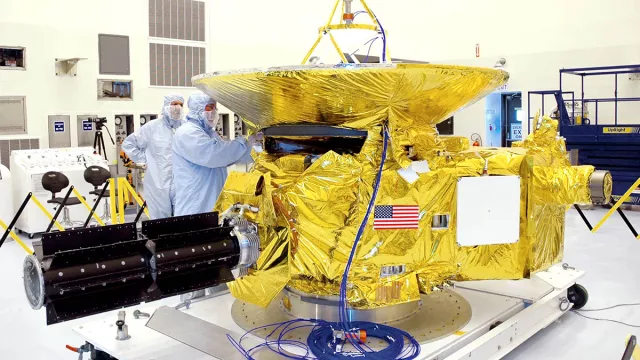The New Horizons probe was developed by NASA to explore and gain new insights into the Pluto system at the outer reaches of our solar system, in the Kuiper Belt beyond Neptune. This belt is a ring of small icy bodies that are remnants from the solar system’s formation.
Key information
| Mission | Study the Pluto system and Kuiper Belt with close flybys to observe several small bodies |
|---|---|
| Domain | Science |
| Launch date | 19 January 2006 |
| Partners | NASA, Johns Hopkins University Applied Physics Laboratory (APL), Southwest Research Institute (SwRI), Stanford University, NASA Goddard Space Flight Center (GSFC). |
| Where | Flyby of Pluto and exploration of Kuiper Belt |
| Lifetime | End of mission in 2030s |
| Status | In operation |
Key figures
- 478 kg: spacecraft mass
- 8 instruments
Key milestones
- 2030s: End of mission
- 1 January 2019: Flyby of trans-Neptunian Kuiper Belt object Arrokoth
- 1 July 2016: NASA extends mission to 2021
- 14 July 2015: Flyby of Pluto
- 9 July 2012: Pluto’s moon Styx discovered
- 20 July 2011: Pluto’s moon Kerberos discovered
- 28 February 2007: Jupiter gravity assist
- 19 January 2006: New Horizons launched by par Atlas V-551
- 15 May 2005: Pluto’s moons Nix and Hydra discovered
- 19 November 2001: NASA selects project
- 2000: Start of New Horizons project
Project in brief
New Horizons is the first mission of NASA’s New Frontiers programme of medium-class planetary exploration missions launched every five years. The mission was approved in 2000 at a time when Pluto was still considered by scientists to be a planet, before it was reclassified as a dwarf planet in 2006.
Most of the probe’s instruments are from the United States, but several European scientists are on the New Horizons science team.
New Horizons is one of the fastest spacecraft ever built. After a gravity boost from Jupiter in 2007 and a journey of some five billion kilometres, the 480-kilogram probe, smaller than a grand piano, flew by the Pluto system in July 2015. The flyby was completely automatic.
The first flyby of the dwarf planet Pluto, the largest Kuiper Belt object (KBO), spanning roughly 2,380 kilometres, its main satellite Charon and four small moons (Styx, Nix, Kerberos and Hydra) collected a wealth of data. While the flyby only lasted a few days, it took more than a year to beam the data back to Earth.
New Horizons observed clearly visible layers of nitrogen haze in Pluto’s atmosphere, a great diversity of relief including some cryovolcanoes, the notable absence of craters in certain regions (particularly Sputnik Planitia, the largest nitrogen ice glacier in the solar system), mountains of water ice and moving glaciers. The dwarf planet’s surface appears to be young.
The Pluto-Charon system can be likened to the Earth-Moon system, except Charon is half the size of Pluto. New Horizons also discovered a phenomenon not seen in the solar system before: Pluto’s atmosphere escapes towards Charon in ‘summer’, depositing heavy hydrocarbons on Charon’s surface that are visible at its north pole, giving it its dark hue. These hydrocarbons are tholins, complex organic substances containing varying levels of nitrogen that are abundant in the solar system but not found on Earth.
Pluto’s small moons show traces of impacts and could be fragments from a collision between Pluton and a large KBO.
New Horizons is still going strong after flying within 3,500 kilometres of a small KBO spanning roughly 27 kilometres called Arrokoth (2014 MU69) on 1 January 2019. The objective of this flyby was to study a common object in the belt like the thousands of others already catalogued to understand how such small bodies have evolved since they were formed.
No further close flybys are planned after this encounter, but the probe’s camera should allow other KBOs to be observed for another 10 years or so. All being well, the probe will continue to send back images until its radioisotope thermal electric generator (RTG) runs out of fuel. We will thus be able to learn more about the outer reaches of our solar system and possibly beyond. With its missions accomplished and propelled by its momentum, New Horizons will then become only the fifth man-made spacecraft to leave the solar system.
CNES’s role
CNES is supporting the French research laboratories involved in the mission.
Contacts
Solar System Planets and Small Bodies subject matter expert
Francis Rocard
E-mail: francis.rocard at cnes.fr


